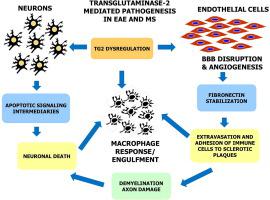Neuroscience ( IF 2.9 ) Pub Date : 2020-11-27 , DOI: 10.1016/j.neuroscience.2020.11.034 Damien D Pearse 1 , Peter Anthony Otero 2 , Ashley Diaz 2 , Xiaoqi Pan 2 , Mousumi Ghosh 3

|
Transglutiminase-2 (TG2) is a multifunctional enzyme that has been implicated in the pathogenesis of experimental autoimmune encephalomyelitis (EAE) and multiple sclerosis (MS) using global knockout mice and TG2 selective inhibitors. Previous studies have identified the expression of TG2 in subsets of macrophages-microglia and astrocytes after EAE. The aims of the current investigation were to examine neuronal expression of TG2 in rodent models of chronic-relapsing and non-relapsing EAE and through co-staining with intracellular and cell death markers, provide insight into the putative role of TG2 in neuronal pathology during disease progression. Here we report that under normal physiological conditions there is a low basal expression of TG2 in the nucleus of neurons, however following EAE or MS, robust induction of cytoplasmic TG2 occurs in most neurons surrounding perivascular lesion sites. Importantly, TG2-positive neurons also labeled for phosphorylated Extracellular signal-regulated kinase 1/2 (ERK1/2) and the apoptotic marker cleaved caspase-3. In white and gray matter lesions, high levels of TG2 were also found within the vasculature and endothelial cells as well as in tissue migrating pericytes or fibroblasts, though rarely did TG2 colocalize with cells identified with glial cell markers (astrocytes, oligodendrocytes and microglia). TG2 induction occurred concurrently with the upregulation of the blood vessel permeability factor and angiogenic molecule Vascular Endothelial Growth Factor (VEGF). Though molecular and pharmacological studies have implicated TG2 in the induction and severity of EAE, the cell autonomous functions of this multifunctional enzyme during disease progression remains to be elucidated.
中文翻译:

实验性自身免疫性脑脊髓炎和多发性硬化期间神经元和内皮转谷氨酰胺酶 2 的表达
转谷氨酰胺酶 2 (TG2) 是一种多功能酶,它与使用全局基因敲除小鼠和 TG2 选择性抑制剂的实验性自身免疫性脑脊髓炎 (EAE) 和多发性硬化症 (MS) 的发病机制有关。以前的研究已经确定了 TG2 在 EAE 后巨噬细胞-小胶质细胞和星形胶质细胞亚群中的表达。当前研究的目的是检查慢性复发和非复发 EAE 啮齿动物模型中 TG2 的神经元表达,并通过与细胞内和细胞死亡标志物共染色,提供对 TG2 在疾病期间神经元病理学中推定作用的见解进展。在这里,我们报告在正常生理条件下,神经元核中 TG2 的基础表达较低,但是在 EAE 或 MS 之后,细胞质 TG2 的强烈诱导发生在血管周围病变部位周围的大多数神经元中。重要的是,TG2 阳性神经元也被标记为磷酸化的细胞外信号调节激酶 1/2 (ERK1/2) 和凋亡标记裂解 caspase-3。在白质和灰质病变中,在脉管系统和内皮细胞以及组织迁移的周细胞或成纤维细胞中也发现了高水平的 TG2,尽管 TG2 很少与神经胶质细胞标记物(星形胶质细胞、少突胶质细胞和小胶质细胞)共定位。TG2 诱导与血管通透性因子和血管生成分子血管内皮生长因子 (VEGF) 的上调同时发生。尽管分子和药理学研究表明 TG2 与 EAE 的诱导和严重程度有关,







































 京公网安备 11010802027423号
京公网安备 11010802027423号